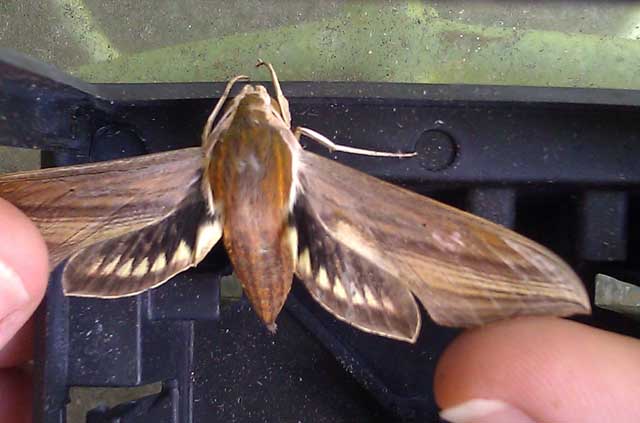
Xylophanes tersa, Sarasota, Sarasota County, Florida, courtesy of Phoenix Rae Wilde.
|
|
Created/dedicated as per personal communication with Phoenix Rae Wilde, September 19, 2011 Updated as per James P. Tuttle's The Hawk Moths of North America, September 19, 2011 Updated as per BAMONA, September 19, 2011 Updated as per personal communication with Mike Soukup; April 13,2022 |

Xylophanes tersa, Sarasota, Sarasota County, Florida, courtesy of Phoenix Rae Wilde.
Phoenix writes, "Hello Bill! I live in Sarasota, FL, and have begun to notice that my backyard is an entomologists' playground! I am not any kind of expert, I am just an M.A. un nursing school and run a clinic at a medical school of Eastern/Western medicine, but I have been having so much fun finding and identifying all the weird creatures in my backyard that I have become quite good at getting pictures and detailed descriptions of my tiny little friends! Most recently I encountered a large moth that I believe is from your site so I will include some pictures and you see if you can tell me if I am right or not? I have so many pictures ranging from snails and slugs to several species of spiders and even managed to capture some VERY up close shots of a cicada and a video of some carnivorous bees demolishing a poor caterpillar. So I thank you so much for your time and hopefully you find this as fun as I do!"
Gary McClellan writes, "Yesterday I posted four pics to bugguide. This cat is a good four inches. A friend found it feeding on Duranta. Overnight it fed on cuttings I brought home with me. This morning I was amazed at the color change. I purchased a one gallon potted Duranta. Within fifteen minutes of transferring the cat, it burrowed below the soil. Went looking for more info and found your site. Also saw referrals to you on other sites.
"Is the overnight color change an indication?"
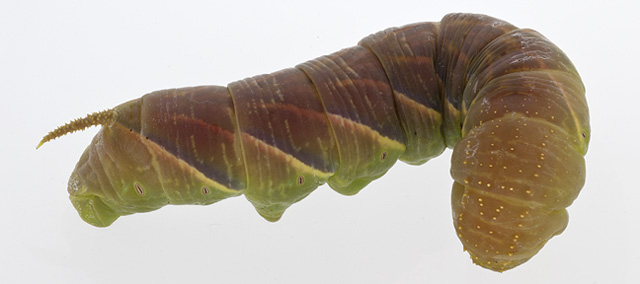
Manduca rustica prepupal, Sarasota, Sarasota County, Florida,
July 19, 2014, courtesy of Gary McClellan
On August 16, Gary adds, "Hi Bill,
"Yesterday morning I found this already emerged. Nice size hole underneath the host plant.
After a few pics I set the moth free. Here�s a couple if you want to add."
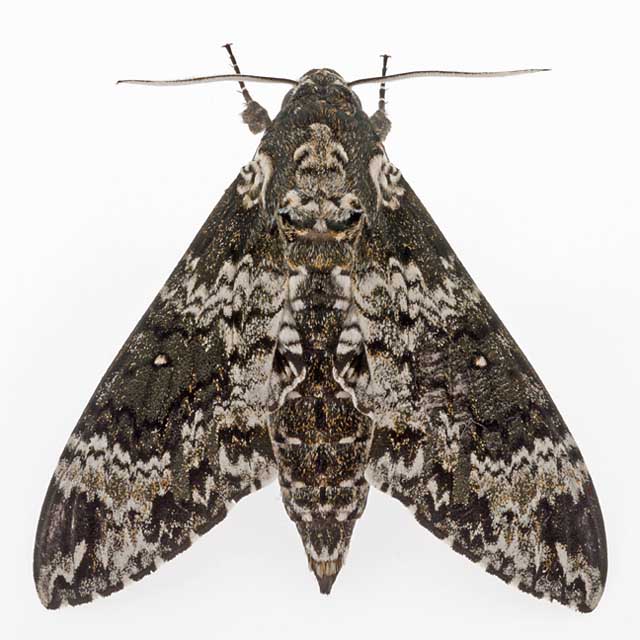
Manduca rustica, Sarasota, Sarasota County, Florida,
August 15, 2014, Gary McClellan.
A "WO" after the species name indicates that I have no confirmed reports of this species in your county, but I (William Oehlke) expect that this moth is present or might be present.
Many thanks to Mike Soukup who provides the following image, confirming
Darapsa versicolor North Port, Sarasota County, Florida,
Please help me develop this list with improved, documented accuracy by sending sightings (species, date, location), preferably with an
electronic image, via email to Bill Oehlke. Please also send your sightings to BAMONA, an excellent online reource.
The night-blooming moon flower will attract many Sphingidae at dusk and into the night.
Visit Sarasota County Sphingidae: Caterpillars; Hornworms
Visit Forida Catocala: Underwing Moths
Listed as parce on BAMONA.
Nominate pseudothyreus is probably limited to Cuba, and Madoryx pseudothyreus bahamensis replaces
pseudothyreus in the Bahamas.
Enjoy some of nature's wonderments, giant silk moth cocoons.
These cocoons are for sale winter and fall. Beautiful Saturniidae moths will emerge the following spring and summer.
Read Actias luna rearing article.
Additional online help available. Eggs of many North American species are offered during the spring and summer. Occasionally
summer Actias luna and summer Antheraea polyphemus cocoons are available. Shipping to US destinations is done
from with in the US.
Use your browser "Back" button to return to the previous page.
This page is brought to you by Bill Oehlke and the
WLSS. Pages are on space rented from Bizland. If you would like to become a "Patron of the Sphingidae Site", contact Bill.
Please send sightings/images to Bill. I will do my best to respond to requests for identification help.

April 12, 2022, courtesy of Mike Soukup.Sphinginae subfamily

Agrius cingulata, WO Pink-spotted hawkmoth.
This species is a strong migrant and adults nectar from deep-throated flowers including moonflower (Calonyction aculeatum),
morning glory (Convolvulus), honey suckle (Lonicera) and petunia (Petunia species).

Ceratomia amyntor WO??, Elm Sphinx; Four-horned Sphinx.
The upperside of the forewing is brown with dark brown and white markings including a white costal area near the wing base, dark streaks along the veins,
and a white spot in the cell. Larvae feed on Elm (Ulmus), birch (Betula), basswood (Tilia), and
cherry (Prunus). unlikely, generally more northerly

Ceratomia catalpae WO, Catalpa Sphinx.
The upperside of the forewing is yellowish brown with no white markings, but there are indistinct black lines and dashes. The cell spot is gray with a black outline.
The larvae feed in large groups and are much more spectacular than the moths.
Catalpa is the larval host.
Ceratomia undulosa BAMONA, Waved Sphinx.
The upperside of the forewing is pale brownish gray with wavy black and white lines and a black-outlined white cell spot. The upperside of the hindwing is gray with
diffuse darker bands.
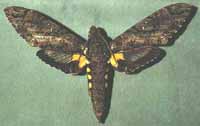
Cocytius antaeus, WO?? unlikely stray Giant Sphinx.
The upperside of the forewing is a blurry yellowish gray. The upperside of the hindwing is dark gray with yellow at the base and a
dark "tooth" projecting from the margin into the translucent area between each vein.

Dolba hyloeus BAMONA, Pawpaw Sphinx.
The upperside of the forewing is dark brown with a dusting of white scales. Some moths have patches of reddish or yellowish brown on the wings.
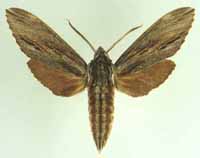
Isoparce cupressi WO, Cypress; Baldcypress Sphinx.
Isoparce cupressi, the rare Cypress Sphinx, flies in Cypress swamps in Georgia (specimen type locality), and from Maryland to Texas.
It has been reported in Mexico.

Lapara coniferarum WO, Southern Pine Sphinx.
The upperside is of the forewing is gray with two (sometimes one or three) black dashes near the wing center; other
markings are usually diffuse. The upperside of the hindwing is a uniform brown-gray. If you've got pines, this species is likely present.

Manduca jasminearum WO, Ash Sphinx.
The upperside of forewing is gray to grayish brown with a black line running from the middle of the costa to the middle of the outer
margin; the line may be broken near the margin. There is a splash of brown around the cell spot.

Manduca quinquemaculatus WO, Five-spotted Hawkmoth.
If you grow tomatoes, you might encounter Manduca quinquemaculatus.

Manduca rustica WO/GM, Rustic Sphinx.
Look for three large yellow spots on each side of the abdomen. The upperside of the forewing is yellowish brown to deep chocolate brown with a dusting of white
scales and zigzagged black and white lines.

Manduca sexta WO, Carolina Sphinx.
If you grow tomatoes, you have probably encountered Manduca sexta in the larval stage.
Larvae get very large and can strip a tomato plant.

Paratrea plebeja BAMONA, Plebeian Sphinx. The upperside of the forewing is gray with indistinct black and
white markings. There is a series of black dashes from the base to the tip, and a small white cell spot.

Sphinx gordius WO, Apple Sphinx.
The upperside of the forewing ranges from brown with black borders through brownish gray with paler borders to pale gray with no borders.
Smerinthini Tribe:

Amorpha juglandis WO, Walnut Sphinx.
The adults are also highly variable; sometimes wings of an individual may be all one color or may have several colors, ranging from pale to
dark brown, and may have a white or pink tinge. Patterns range from faint to pronounced. Female is different.

Paonias excaecata WO, Blinded Sphinx.
Named for the dull grey-blue spot (minus dark pupil) in the hindwing, this moth has a wide distribution in the eastern United States.
I regularly see them on Prince Edward Island, and they are reported as far south as southern Florida.

Paonias myops WO, Small-eyed Sphinx.
Named for the small eye-spot in the hindwing, this moth has a wide distribution and is probably present in Manatee County.
I regularly see them on Prince Edward Island, and they are reported as far south as southern Florida.

Smerinthus jamaicensis WO??, generally more northerly, Twin-spotted Sphinx.
This moth is widely distributed and fairly common. Along the East Coast, it flies from P.E.I. to Florida.
slight possibility, generally more northerly
Protambulyx strigilis, Sarasota, December 17, 2011, John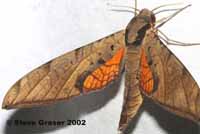
Protambulyx strigilis BAMONA, Streaked Sphinx:
The inner margin of the forewing is indented. The upperside of the forewing is pale yellowish gray in the pale form and reddish brown in
the dark form. Both forms have a distinct submarginal line and a dark band along the indentation in the inner margin. Listed as carteri on BAMONA.
Macroglossinae subfamily
Dilophonotini tribe:
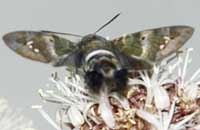
Aellopos tantalus BAMONA, Tantalus Sphinx.
The body is reddish brown with a wide white band across the abdomen. The forewing upperside is reddish brown with a black cell spot and 3
white spots near the gray marginal area. A pale streak runs from the cell spot to the inner margin of the wing.
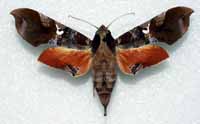
Callionima falcifera BAMONA.
This species is reddish, has falcate wings and flies after midnight.
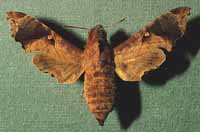
Enyo lugubris, the Mournful Sphinx, WO.
The body and wings are dark brown. The forewing has a large black patch covering most of the outer half of the wing. There is a pale
tan cell spot (dark inner pupil), and a fairly straight median line to the inside of the cell spot.
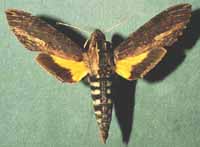
Erinnyis alope WO, Alope Sphinx.
The upperside of the forewing is dark brown with short yellowish streaks on the forward half and wavy yellowish bands on the rear half.

Erinnyis ello WO, Ello Sphinx.
The abdomen has very distinct gray and black bands. The female's forewing upperside is pale gray with a few dark dots near the outer margin.
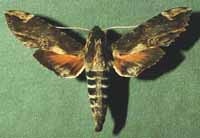
Erinnyis lassauxi BAMONA, Dominican Sphinx
This moth flies in Haiti and Jamaica south to Paraguay and Bolivia with occasional sightings in Texas and Arizona, and possibly Florida.

Erinnyis obscura, the Obscure Sphinx, WO.
During the night adults nectar at flowers, including bouncing bet (Saponaria officinalis) and Asystasia gangetica beginning at dusk.
July and August are flight times in the southern states. possibility
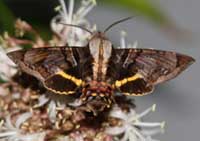
Eupyrrhoglossum sagra, Cuban Sphinx, WO.
The wide brown band down the center of the creamy-grey thorax and uppe rhalf of the abdomen, as well as the bright hindwing yellow band
clearly distinguish this species.
See Hemaris comparison to help distinguish the next two species.

Hemaris thysbe BAMONA, Hummingbird Clearwing.
It is not difficult to see why many gardeners would mistake an Hemaris thysbe moth for a small hummingbird as it hovers,
sipping nectar from flowers through a long feeding tube.

Hemaris gracilis WO, Slender Clearwing; Graceful Clearwing.
This day-flying moth is less common and has not been recorded in Manatee County, but it may be present. unlikely
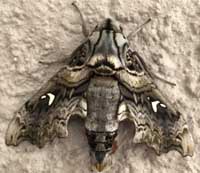
Madoryx pseudothyreus floridensis, the Floridian False-windowed Sphinx,
BAMONA
The wing margins are scalloped. The upperside of the forewing is
brown with dark brown and tan markings. The forewing has a V-shaped
white spot near the center of the costa.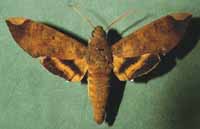
Pachylia ficus, Fig Sphinx, WO.
The upperside of the forewing is orangish brown with a paler patch along the costa at the tip.
The upperside of the hindwing is orange to orangish brown with a black outer border, a black median band, and a white spot on the outer margin near the body.
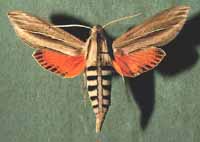
Phryxus caicus, Caicus Sphinx, BAMONA. Abdomen of the Caicus sphinx has distinct black and tan bands.
The upperside of the forewing is brown with a tan band along inner margin and thin tan streak in middle of wing.

Pachylia ficus, Fig Sphinx, WO?? unlikely stray.
Orangish brown with paler patch along costa at tip. The upperside of the hindwing is orange to orangish brown with a black outer border, a
black median band, and a white spot on the outer margin near the body.
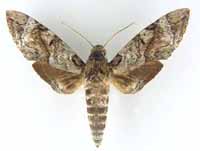
Pseudosphinx tetrio, Tetrio Sphinx,
BAMONA.
The upperside of the forewing is dark brown with a dark spot at the
base of the costa and blurry gray and white markings. The upperside
of the hindwing is dark brown with white along the inner margin, and
the lower half of the outer margin. big, colourful larva
Philampelini tribe:

Eumorpha achemon WO, Achemon Sphinx.
Larvae get large and feed on grape vines and Virginia creeper. Note the differences between this moth and the Pandorus Sphinx.

Eumorpha fasciatus BAMONA, Banded Sphinx.
The upperside of the moth is dark pinkish brown. Each forewing has a lighter brown band along the costa, and sharp pinkish white bands and
streaks. Larvae feed upon primrose-willow, Ludwigia (water primrose) and other plants in the evening primrose family.

Eumorpha pandorus WO, Pandorus Sphinx.
If you have Grape or Virginia Creeper nearby, then you probably have this species. I often get asked to identify larvae from areas not previously reported.
Macroglossini tribe:

Amphion floridensis BAMONA, Nessus Sphinx.
This day flier is widely distributed. If you have Virginia Creeper, you probably have the Nessus Sphinx. Two bright, distinct, narrow yellow
bands are often visible on the abdomen.
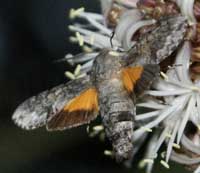
Cautethia grotei BAMONA, Grote's Sphinx:
Pale silvery gray with black markings; in some moths wing base may be very dark.
Hindwing deep yellow-orange with black border that covers less than half wing.
This species is rarely recorded in the U.S., but there are sightings
from Florida, South Carolina, New Jersey, New York,
Massachusetts, New Hampshire, with northen sightings being rare strays.

Darapsa choerilus WO, Azalea Sphinx.
The lower wings of this hawkmoth are a solid brownish-orange, matching the body colour.
You will often see this species listed as Darapsa pholus, especially in older literature.

Darapsa myron WO/MS, Virginia Creeper Sphinx or the
Grapevine Sphinx. If you have the foodplants indicated in the common names, you probably have this species nearby. The lower wings are orange.
Florida specimens tend to have uniform, drab, grey-green or pale orange-brown forewings without significant markings.
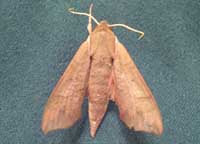
Darapsa myron pale form, WO, Virginia Creeper Sphinx or the
Grapevine Sphinx. If you have the foodplants indicated in the common names, you might have this
species nearby. The lower wings are pinkish-orange. I was quite surprised by the pale colouration of this moth, but that is common for Florida specimens.

Darapsa versicolor WO/MS, Hydrangea Sphinx.
If you have hydrangea growing near a stream, then you might have the
Hydrangea Sphinx.

Hyles lineata BAMONA, White-lined Sphinx.
The forewing upperside is dark olive brown with paler brown along the
costa and outer margin, a narrow tan band running from the wing tip
to the base, and white streaks along the veins.

Sphecodina abbottii WO, Abbott's Sphinx.
This moth is very much under reported across the United States. It
is a rapid day flier so is probably not in too many collections.
Grape is a popular larval host. generally more northerly
Xylophanes tersa, Sarasota, Phoenix Rae Wilde
Xylophanes tersa PRW, Tersa Sphinx.
The upperside of the forewing is pale brown with lavender-gray at the base and
has dark brown lengthwise lines throughout. This moth is a strong migrant.
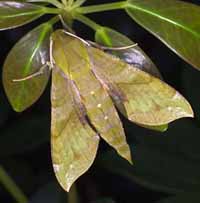
Xylophanes pluto WO// unlikely stray, Pluto Sphinx.
The upperside of the forewing is olive green with a paler median band and pale lines with purple shading along them.
The upperside of the hindwing has a white spot surrounded by black at the base, a wide
orangish yellow median band, and a brown to greenish band along the
outer margin.


Show appreciation for this site by clicking on flashing butterfly to the left.
The link will take you to a page with links to many insect sites.